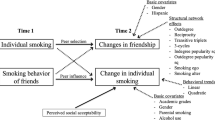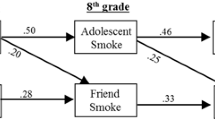Abstract
Peer attributes other than smoking have received little attention in the research on adolescent smoking, even though the developmental literature suggests the importance of multiple dimensions of adolescent friendships and peer relations. Social network analysis was used to measure the structure of peer relations (i.e., indicators of having friends, friendship quality, and status among peers) and peer smoking (i.e., friend and school smoking). We used three-level hierarchical growth models to examine the contribution of each time-varying peer variable to individual trajectories of smoking from age 11 to 17 while controlling for the other variables, and we tested interactions between the peer structure and peer smoking variables. Data were collected over five waves of assessment from a longitudinal sample of 6,579 students in three school districts. Findings suggest a greater complexity in the peer context of smoking than previously recognized.

Similar content being viewed by others
References
Abel, G., Plumridge, L., & Graham, P. (2002). Peers, networks or relationships: Strategies for understanding social dynamics as determinants of smoking behaviour. Drugs: Education, Prevention and Policy, 9, 325–338.
Alexander, C., Piazza, M., Mekos, D., & Valente, T. (2001). Peers, school, and adolescent cigarette smoking. Journal of Adolescent Health, 29, 22–30.
Allen, J. P., Porter, M. R., McFarland, F. C., March, P., & McElhaney, K. B. (2005). The two faces of adolescents’ success with peers: Adolescent popularity, social adaptation, and deviant behavior. Child Development, 76, 747–760.
Allison, P. D. (2002). Missing data. Thousand Oaks, CA: Sage.
Bauman, K. E., & Ennett, S. T. (1996). On the importance of peer influence for adolescent drug use: Commonly neglected considerations. Addiction, 91, 185–198.
Bauman, K. E., Faris, R., Ennett, S. T., Hussong, A., & Foshee, V. A. (2007). Adding valued data to basic social network measures: Does it add to prediction of adolescent substance use? Social Networks, 29, 1–10.
Bearman, P. S., & Moody, J. (2004). Suicide and friendships among American adolescents. American Journal of Public Health, 94, 89–95.
Berkman, L. F., Glass, T., Brissette, I., & Seeman, T. E. (2000). From social integration to health: Durkheim in the new millennium. Social Science & Medicine, 51, 843–857.
Berndt, T. J. (1982). The features and effects of friendship in early adolescence. Child Development, 53, 1447–1460.
Borgatti, S. P., Everett, M. G., & Freeman, L. C. (2002). Ucinet for windows: Software for social network analysis (Version 6). Harvard, MA: Analytic Technologies.
Chassin, L., Presson, C. C., Sherman, S. J., Montello, S. J., & McGrew, J. (1986). Changes in peer and parent influence during adolescence: Longitudinal versus cross-sectional perspectives on smoking initiation. Developmental Psychology, 3, 327–334.
Crosnoe, R. (2000). Friendships in childhood and adolescence: The life course and new directions. Social Psychology Quarterly, 63, 377–391.
Crosnoe, R., & Needham, B. (2004). Holism, contextual variability, and study of friendships in adolescent development. Child Development, 75, 264–279.
Curran, P. J., Bauer, D. J., & Willoughby, M. T. (2004). Testing and probing main effects and interactions in latent curve analysis. Psychological Methods, 9, 220–237.
Curran, P. J., & Hussong, A. M. (2003). The use of latent trajectory models in psychopathology research. Journal of Abnormal Psychology, 112, 526–544.
Dishion, T., Andrews, T., & Crosby, L. (1995). Antisocial boys and their friends in early adolescence: Relationship characteristics, quality, and interactional process. Child Development, 66, 139–151.
Duncan, S. C., Duncan, T. E., & Hops, H. (1996). Analysis of longitudinal data with accelerated longitudinal designs. Psychological Methods, 1, 236–248.
Eder, D. (1985). The cycle of popularity: Interpersonal relations among female adolescents. Sociology of Education, 58, 154–165.
Ennett, S. T., & Bauman, K. E. (1993). Peer group structure and adolescent cigarette smoking: A social network analysis. Journal of Health & Social Behavior, 34, 226–236.
Ennett, S. T., & Bauman, K. E. (1994). The contribution of influence and selection to adolescent peer group homogeneity: The case of adolescent cigarette smoking. Journal of Personality & Social Psychology, 67, 653–663.
Ennett, S. T., Bauman, K. E., Hussong, A., Faris, R., Foshee, V. A., DuRant, R. H., et al. (2006). The peer context of adolescent substance use: Findings from social network analysis. Journal of Research on Adolescence, 16, 159–186.
Fang, X., Li, X., Stanton, B., & Dong, Q. (2003). Social network position and smoking experimentation among Chinese adolescents. American Journal of Health Behavior, 27, 257–267.
Giordano, P. C. (2003). Relationships in adolescence. Annual Review of Sociology, 29, 257–281.
Hartup, W. W. (1996). The company they keep: Friendships and their developmental significance. Child Development, 61, 1–13.
Haynie, D. L. (2001). Delinquent peers revisited: Does network structure matter? American Journal of Sociology, 106, 1013–1057.
Heatherton, T. F., Kozlowski, L. T., Frecker, R. C., & Fagerstrom, K. O. (1991). The Fagerstrom Test for Nicotine Dependence: A revision of the Fagerstrom Tolerance Questionnaire. British Journal of Addiction, 86, 1119–1127.
Hoffman, B. R., Sussman, S., Unger, J. B., & Valente, T. (2006). Peer influence on adolescent cigarette smoking: A theoretical review of the literature. Substance Use and Misuse, 41, 103–155.
Horton, N. J., & Lipsitz, S. R. (2001). Multiple imputation in practice: Comparison of software packages for regression models with missing variables. The American Statistician, 55, 244–254.
Knoke, D., & Kuklinski, J. H. (1982). Network analysis. Beverly Hills, CA: Sage.
Kobus, K. (2003). Peers and adolescent smoking. Addiction, 98 (Suppl 1), 37–55.
Krohn, M. D., Massey, J. L., Skinner, W. F., & Lauer, R. M. (1983). Social bonding theory and adolescent cigarette smoking: A longitudinal analysis. Journal of Health & Social Behavior, 24, 337–349.
Maggs, J. L., & Hurrelmann, K. (1998). Do substance use and delinquency have differential associations with adolescent peer relations. International Journal of Behavioral Development, 22, 367–388.
Michell, L., & Amos, A. (1997). Girls, pecking order and smoking. Social Science and Medicine, 44, 1861–1869.
Moody, J. (2000) SPAN: SAS programs for analyzing networks [web page]. URL: http://www.sociology.ohio-state.edu/jwm/soc_net_methods.htm.
Moody, J. (2001). Peer influence groups: Identifying dense clusters in large networks. Social Networks, 23, 261–283.
Pearson, M., & Michell, L. (2000). Smoke rings: Social network analysis of friendship groups, smoking, and drug-taking. Drugs: Education, Prevention, and Policy, 7, 21–37.
Pearson, M., & West, P. (2003). Drifting smoke rings: Social network analysis and Markov processes in a longitudinal study of friendship groups and risk-taking. Connections, 25, 59–76.
SAS (2002–2003). SAS 9.1. for Windows. Cary, NC: SAS Institute, Inc.
Savin-Williams, R. C., & Berndt, T. J. (1990). Friendship and peer relations. In S. B. Feldman & G. R. Elliott (Eds.), At the threshold. The developing adolescent (pp. 277–307). Cambridge, MA: Harvard University Press.
Scott, J. (2000). Social network analysis: A handbook (2nd ed.). London: Sage.
Sellstrom, E., & Bremberg, S. (2006). Is there a “school effect” on pupil outcomes? A review of multilevel studies. Journal of Epidemiology and Community Health, 60, 149–155.
Steglich, C., Snijders, T., & Pearson, M. (2004). Dynamic networks and behavior: Separating influence from selection. Unpublished manuscript available at http://stat.gamma.rug.nl/snijders/SSP_total.pdf.
Thissen, D., Chen, W.-H., & Bock, R. D. (2003). Multilog (Version 7). Lincolnwood, IL: Scientific Software International.
Thissen, D., & Orlando, M. (2001). Item response theory for items scored in two categories. In D. Thissen, & H. Wainer (Eds.), Test scoring (pp. 73–140). Hillsdale, NJ: Erlbaum.
Urberg, K. A., Luo, Q., Pilgrim, C., & Degirmencioglu, S. M. (2003). A two-stage model of peer influence in adolescent substance use: Individual and relationship-specific differences in susceptibility to influence. Addictive Behaviors, 28, 1243–1256.
Valente, T. W., Gallaher, P., & Mouttapa, M. (2004). Using social networks to understand and prevent substance use: A transdisciplinary perspective. Substance Use and Misuse, 39, 1685–1712.
Wasserman, S., & Faust, K. (1994). Social network analysis: Methods and applications. New York: Cambridge University Press.
Acknowledgment
This research was supported by a grant from the National Institute on Drug Abuse (R01 DA13459). An earlier version of this paper was presented at the Applications of Social Network Analysis to the Prevention of Substance Use and Delinquency Conference held November 11, 2005 at Pennsylvania State University.
Author information
Authors and Affiliations
Corresponding author
Rights and permissions
About this article
Cite this article
Ennett, S.T., Faris, R., Hipp, J. et al. Peer Smoking, Other Peer Attributes, and Adolescent Cigarette Smoking: A Social Network Analysis. Prev Sci 9, 88–98 (2008). https://doi.org/10.1007/s11121-008-0087-8
Received:
Accepted:
Published:
Issue Date:
DOI: https://doi.org/10.1007/s11121-008-0087-8




